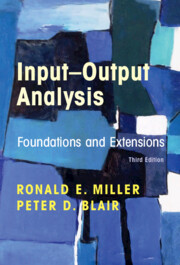Book contents
- Input–Output Analysis
- Input–Output Analysis
- Copyright page
- Contents
- Figures
- Tables
- Preface
- 1 Introduction and Overview
- 2 Foundations of Input–Output Analysis
- 3 Input–Output Models at the Regional Level
- 4 Organization of Basic Data for Input–Output Models
- 5 The Commodity-by-Industry Approach in Input–Output Models
- 6 Multipliers in the Input–Output Model
- 7 Supply-Side Models, Linkages, and Important Coefficients
- 8 Decomposition Approaches
- 9 Nonsurvey and Partial-Survey Methods:
- 10 Nonsurvey and Partial-Survey Methods:
- 11 Social Accounting Matrices
- 12 Energy Input–Output Analysis
- 13 Environmental Input–Output Analysis
- 14 Mixed and Dynamic Models
- 15 Additional Topics
- Postscript
- Book part
- Author Index
- Subject Index
- References
4 - Organization of Basic Data for Input–Output Models
Published online by Cambridge University Press: 06 January 2022
- Input–Output Analysis
- Input–Output Analysis
- Copyright page
- Contents
- Figures
- Tables
- Preface
- 1 Introduction and Overview
- 2 Foundations of Input–Output Analysis
- 3 Input–Output Models at the Regional Level
- 4 Organization of Basic Data for Input–Output Models
- 5 The Commodity-by-Industry Approach in Input–Output Models
- 6 Multipliers in the Input–Output Model
- 7 Supply-Side Models, Linkages, and Important Coefficients
- 8 Decomposition Approaches
- 9 Nonsurvey and Partial-Survey Methods:
- 10 Nonsurvey and Partial-Survey Methods:
- 11 Social Accounting Matrices
- 12 Energy Input–Output Analysis
- 13 Environmental Input–Output Analysis
- 14 Mixed and Dynamic Models
- 15 Additional Topics
- Postscript
- Book part
- Author Index
- Subject Index
- References
Summary
Chapter 4 deals with the construction of input–output tables from standardized conventions of national economic accounts, such as the widely used System of National Accounts (SNA) promoted by the United Nations, including a basic introduction to the so-called commodity-by-industry or supply-use input–output framework developed in additional detail in Chapter 5. A simplified SNA is derived from fundamental economic concepts of the circular flow of income and expenditure, that is, as additional sectoral details are defined for businesses, households, government, foreign trade, and capital formation, ultimately result in the basic commodity-by-industry formulation of input–output accounts. The process is illustrated with the US input–output model and some of the key traditional conventions widely applied for such considerations as secondary production (multiple products or commodities produced by a business), competitive imports (commodities that are also produced domestically) versus non-competitive imports (commodities not produced domestically), trade and transportation margins on interindustry transactions, or the treatment of scrap and secondhand goods.
Keywords
Information
- Type
- Chapter
- Information
- Input-Output AnalysisFoundations and Extensions, pp. 112 - 175Publisher: Cambridge University PressPrint publication year: 2022
